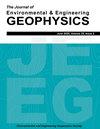利用时移电阻率成像和频域电磁法研究洛山坝填土路堤内部缺陷
IF 0.7
4区 工程技术
Q4 ENGINEERING, GEOLOGICAL
引用次数: 2
摘要
利用电阻率成像(ERI)和频域电磁(FDEM)方法,研究了洛沙内大坝内部易发生渗漏和内部侵蚀的区域结构。时间推移ERI测量也进行了为期8个月,以监测缺陷区的时间演变。FDEM和ERI测量的结果显示了两个主要层。第一个是上部导电层,厚度从10到25 m不等,与粘土岩心堤防有关。位于这层导电层下面的是一个高电阻结晶基底,大坝就建在上面。此外,ERI和FDEM测量结果显示,坝基内部存在裂缝和可能的薄弱区域。延时ERI测量显示,在观察到的可能有缺陷的区域,包括溢洪道附近和堤坝-基础界面,电阻率增加。电阻率的长期变化可能表明坝体这些部分的物质性质发生了变化,并可能随着时间的推移而破坏坝体的结构完整性,或发展成优先的渗流路径。发现的异常带是堤防完整性受到威胁的良好指标,我们建议对洛山大坝结构进行持续的地球物理监测,以确保大坝的长期安全和完整性。本文章由计算机程序翻译,如有差异,请以英文原文为准。
Investigating the Earth Fill Embankment of the Lotsane Dam for Internal Defects Using Time-lapse Resistivity Imaging and Frequency Domain Electromagnetics
We investigated the internal structure of the Lotsane Dam for zones that may be prone to seepage and internal erosion using the electrical resistivity imaging (ERI) and the frequency domain electromagnetic (FDEM) methods. Time-lapse ERI measurements were also made for a period of 8 months in order to monitor the temporal evolution of defective zones. Results from both the FDEM and ERI measurements show two main layers. The first is an upper conductive layer varying in thickness from 10 to 25 m which is related to the clay core embankment. Situated beneath this upper conductive layer is a highly resistive crystalline basement on which the dam was founded. Furthermore, the ERI and FDEM measurements revealed the presence of fractures and possible zones of weakness within the dam foundation. Time-lapse ERI measurements revealed resistivity increases in the observed possible defective zones, including proximal to the spillway and at the embankment-foundation interface. The long-term resistivity variation may be indicating change in material properties in those portions of the dam, and may evolve to destabilize the structural integrity of the dam and or develop into preferential seepage pathways with time. The identified anomalous zones are good indicators that the embankment integrity is at risk and we suggest continuous geophysical monitoring of Lotsane Dam structure in order to ensure dam safety and integrity on the long term.
求助全文
通过发布文献求助,成功后即可免费获取论文全文。
去求助
来源期刊

Journal of Environmental and Engineering Geophysics
地学-地球化学与地球物理
CiteScore
2.70
自引率
0.00%
发文量
13
审稿时长
6 months
期刊介绍:
The JEEG (ISSN 1083-1363) is the peer-reviewed journal of the Environmental and Engineering Geophysical Society (EEGS). JEEG welcomes manuscripts on new developments in near-surface geophysics applied to environmental, engineering, and mining issues, as well as novel near-surface geophysics case histories and descriptions of new hardware aimed at the near-surface geophysics community.
 求助内容:
求助内容: 应助结果提醒方式:
应助结果提醒方式:


